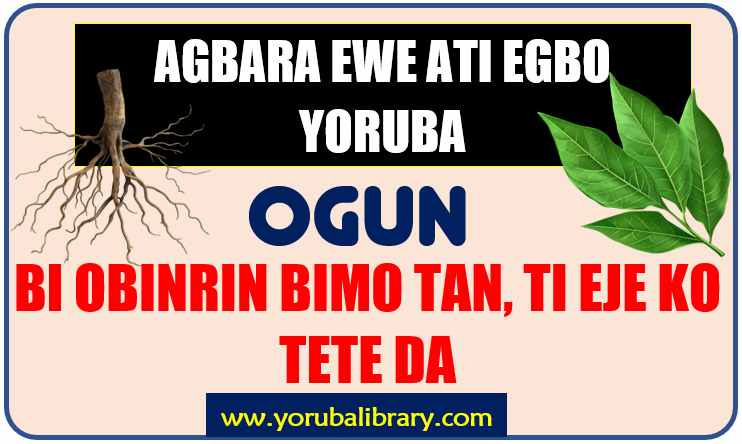
support@yorubalibrary.com
+2348073529208, 07038599574

Among the Yoruba, childbirth is considered a sacred and critical event, but it also carries risks. One of the most dangerous complications is postpartum hemorrhage, when bleeding continues after delivery instead of stopping naturally. Our forefathers in Yoruba land developed Ogun Bi Obinrin Bímọ Tan Ti Ẹjẹ Ko Tẹ́tẹ́ Dá, a traditional healing system designed to control excessive bleeding, restore the mother’s strength, and ensure long-term reproductive health. This remedy goes beyond simply stopping blood flow. Yoruba traditional medicine combines specialized plants and roots to ensure complete recovery. Elders believed that unresolved postpartum bleeding could be worsened in matter of time.
This remedy goes beyond simply stopping blood flow. Yoruba traditional medicine combines specialized plants and roots to ensure complete recovery. Elders believed that unresolved postpartum bleeding could be worsened in matter of time.
For countless years ago, Yoruba women relied on this system in times when hospitals and modern interventions were unavailable. Even today, families continue to use this knowledge as part of their cultural heritage and maternal care practices.
Disclaimer
Yoruba Library and its Team will not be held liable for improper usage or any loss arising from improper use, wrong application, inability to find needed materials, or misinterpretation of this article. This article is provided strictly for guidance and educational purposes.
Symptoms of Postpartum Hemorrhage
Yoruba elders and traditional birth attendants (agbẹ́bí) observed certain signs that indicated the need for immediate intervention:
• Excessive vaginal bleeding after delivery, beyond normal lochia.
• Weakness, dizziness, or fainting due to blood loss.
• Persistent abdominal pain or cramping accompanied by bleeding.
• Restlessness or extreme fatigue following delivery.
• Anxiety or unusual fear regarding recovery.
Elders considered these signs serious and acted quickly with remedies for postpartum hemorrhage to prevent life-threatening outcomes.
How Our Forefathers Treated Postpartum Hemorrhage
Treatment was structured and comprehensive:
• Herbal decoctions to stop bleeding and restore uterine tone.
• Bathing or steaming the mother with selected leaves to strengthen circulation.
• Anointing the abdomen with protective herbal mixtures.
• Collecting herbs, roots, or barks at times of the day believed to enhance potency.
• Combining treatment with rest and dietary care to promote full recovery. Amongst the necessary leaf and barks which our forefathers used in treating postpartum hemorrhage are:
1) Ewe Botuje
2) Ewe Odundun
3) Ewe Iyeye
4) Eru Alamo
5) Egbo Apasa
6) Egbo Akoko
7) Ewe Owu
Have you heard of Yoruba Herb Dictionary? This contains names of Yoruba Leaf, Roots, Barks, Characteristics, Properties & Identification with HD Pictures. Order below or download sample here
A-Z HERBS & LEAF DICTIONARY #4KOne Yoruba proverb says "Bí olóde ò kú, òde rè kì í wu Gbégi". Do you know that Gbégi is actually a leaf/plant? Get Yoruba Proverbs on Plants and Herbs, which is a collection of Untold Wisdoms Hidden in Leaf and plants comprising their Life Applications & Moral Teachings. Order below or download sample here
YORUBA PROVERBS ON PLANTS #4KDifferences Between Yoruba and Modern Postpartum Hemorrhage Treatment
While both Yoruba and modern systems aim to manage postpartum bleeding, their approaches differ:
1) Focus of healing —
Yoruba remedies emphasize physical stabilization, uterine strength, and spiritual protection; modern medicine uses pharmaceuticals, transfusions, or surgery.
2) Materials used —
Yoruba elders used herbs, leaves, and roots; modern medicine relies on synthetic drugs and clinical interventions.
3) Approach to recurrence —
Yoruba healing often includes spiritual cleansing and lifestyle guidance; modern treatment emphasizes ongoing monitoring and emergency protocols.
Safety First: Important Contraindications and Considerations
• Emergency conditions —
Excessive bleeding may require immediate hospital care; traditional remedies complement, not replace, modern intervention.
• Underlying health risks —
Mothers with anemia, hypertension, or other complications must use remedies under careful supervision.
• Quality of source —
Herbs from polluted areas are unsafe and must never be used.
Needed Materials (Leaves, Roots, Bark, etc.)
The medicinal approach for this requires careful selection of natural materials traditionally known to our elders. These are combined to ensure potency.
The instruction you will receive is the original account of our forefathers, preserved and tested over time. Many people have used them with testimonies of relief. Just ensure you follow the correct guidelines. Click Unlock Secret below
Application Process
The strength of Yoruba medicine depends on how materials are handled. Proper pounding, boiling, or steeping — done in the right way and at the right time — ensures the remedy remains potent. Click Unlock Secret below
Uses
The prepared remedy must be applied in the correct manner — whether for drinking, steaming, bathing, or chest rubbing — and taken in the right dosage for it to remain effective.
1) Some leaf required special utterances/chants before they can be effective. Where applicable, this will be stated in the PDF
2) The methods of getting the needed items like leaf, bark, roots by yourself is covered in the PDF
3) Saa bi Ologun ti wi, ki o le baa je... (Follow instructions for it to remain potent). You're getting a Real and Original account of our fore fathers.
With Numerous Satisfied Clients...